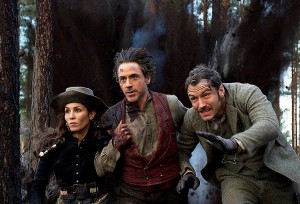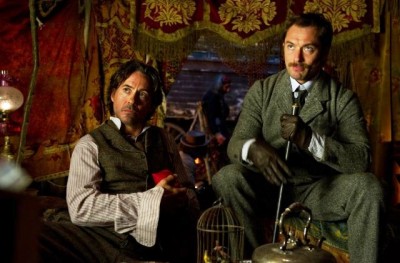
Guy Ritchie’s Sherlock Holmes: A Game of Shadows is that rare thing—the sequel that is better than the original. The standard citing of this—one I’ve used myself—is rating James Whale’s Bride of Frankenstein (1935) over his Frankenstein (1931), but I think a better comparison here would be to put Victor Schertzinger’s Road to Zanzibar (1941) against his Road to Singapore (1940). Same stars, same director, same basic idea, but with more confidence and a sense of its own identity. This is a movie that knows what it is and embraces that at every turn. That should tell you right away whether or not you have any interest in seeing this. If you disliked the first one or have “purist” objections that “this isn’t Sherlock Holmes,” this entry isn’t apt to change your mind.

Oddly, however, there are more things in this entry that can be traced back to the Conan Doyle stories than in the first film. There are inescapable murmurs of “The Final Problem,” since the film pits Holmes (Robert Downey Jr.) against Prof. Moriarty (Jared Harris, The Curious Case of Benjamin Button). A kind of guest appearance by Holmes’ brother Mycroft (Stephen Fry) in that story may well have sparked his inclusion here. And any Holmes’ fan of any kind knows full well where this story is heading the moment that Mycroft complains of the possibility of having to go to a peace conference in Reichenbach. The trick up the movie’s sleeve is how it will get there, and what particular spin it will have on the events. There are also passing references to Anthony Harvey’s They Might Be Giants—just think of the scene in that film when Dr. Mildred Watson (Joanne Woodward) thinks Holmes (George C. Scott) is dead, or Holmes’ glib response to the line, “I thought you were dead.”

Now, before we go any further, let’s get this nonsense about the “appalling” business of Sherlock Holmes in drag, uh, straight. At least one critic has expressed outrage over this. I hate to be the one to disabuse them of how unthinkable this is, but Holmes dresses in drag in at least one story, “The Mazarin Stone,” and appeared on the screen in drag in William K. Howard’s Sherlock Holmes way back in 1932, so the idea is hardly the shocking liberty some want to portray it as.
The film’s story, of course, is all about Holmes and Moriarty theoretically locked in their final battle—and only face-to-face encounter. In this version, Watson (Jude Law) is getting married—with Holmes as unenthused about this as ever (the gay subtext is even more pronounced than in the previous film)—but soon finds his honeymoon rudely interrupted by Holmes because his association with the detective has both he and Mrs. Watson (Kelly Reilly) on Moriarty’s hit list. From there, it’s a more or less simple matter to drag Watson into the battle against the “Napoleon of Crime.”

Irene Adler (Rachel McAdams) makes a brief return in this entry, but, as has been publicized, is quickly dispatched by Moriarty. (However, since we only have his word for her actual death, I’d not rule out her return at some future date.) For a female presence, the film offers instead Noomi Rapace (the original Girl with the Dragon Tattoo) as the gypsy fortune teller Madam Simza Heron, who, though her brother (Laurentiu Possa), is involved in Moriarty’s scheme. (His scheme, by the way, has certain echoes of Moriarty helping the Nazis in the 1942 Sherlock Holmes and the Secret Weapon, but on a much grander scale, as befits the budget of this film.)

Yes, the film is full of action set-pieces, but these are intelligently constructed and fit surprisingly well within the Holmesian proceedings. The tone is right and the characters are right. Downey and Law have even smoother chemistry with each other than they did in the first film. I’m not sure that much more can be asked. At least, I don’t ask more in a case like this. I had a terrific time with the film, will probably see it again, and simply have no serious quibble with any of it. The sight of Holmes astride a gypsy pony is worth much by itself, but the crowning touch of working the actual “Final Problem” into the film’s final scene just made it perfect for me. Rated PG-13 for intense sequences of violence and action, and some drug material.




Spot on! For those that say “this isn’t Sherlock Holmes”, I say, go back and read the stories. When ACD was forced to bring Holmes back, he described to Watson how he used a form of martial arts to throw Moriarty over the falls, and as described in several stories, he was a superb boxer.
But that moment when Holmes realized what he had to do to save his friend, and the look that he and Watson shared was perfect.
I was beginning to think no one else had an opinion on this or had seen it.
There are inescapable murmurs of “The Final Problem,”
As well as chunks of dialogue from it and other stories littered throughout the film.
I saw the text of ‘The Blue Carbuncle’ pop up in the opening ‘presents’ credits.
What a cracking lot of fun. More please.
As well as chunks of dialogue from it and other stories littered throughout the film.
At this point in time, you are undeniably more up on your Conan Doyle than I am.
More please.
Worldwide box office is already at $250 million. I suspect you’ll get more.
At this point in time, you are undeniably more up on your Conan Doyle than I am.
Between the Ritchie movies and the Moffatt/Gatiss telefilms, this is a wonderful time to be a Sherlock Holmes fan.
Somewhat startlingly, I knew Mark Gatiss back when he was but an humble film historian.